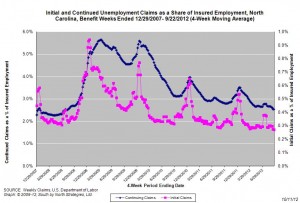The South’s Two Firsts
MDC, Inc. notes the South’s dubious distinction of being the region that is first in college football and first in poverty.
MDC, Inc. notes the South’s dubious distinction of being the region that is first in college football and first in poverty.
Economic policy reports, blog postings, and media stories of interest:
From the Economic Policy Institute’s analysis of the August version of the Job Openings and Labor Turnover Survey (JOLTS) …
The August Job Openings and Labor Turnover Survey (JOLTS), released today by the Bureau of Labor Statistics, underscores the slow-but-steady nature of the recovery. At 3.6 million, job openings in August changed little from July (down 32,000). However, the number of unemployed workers dropped 250,000 in August to 12.5 million (unemployment data are from the Current Population Survey and can be found here), meaning that the “job-seekers ratio”—the ratio of unemployed workers to job openings—declined slightly to 3.5-to-1 from the revised July ratio of 3.6-to-1.
…
Because the job openings data are for August, they do not take into account the September drop in unemployment announced in last Friday’s jobs report, which showed the number of unemployed workers declining by 456,000. This drop means the job-seekers ratio likely declined further in September; for example, if the number of job openings simply changed in September by the average change of the prior three months (-32,000), the job-seekers ratio will have dropped to 3.4-to-1, continuing the improvement the ratio has been experiencing over the last three years. Despite this improvement, odds remain stacked against job seekers; the ratio has been 3-to-1 or greater since Sept. 2008.
Economic policy reports, blog postings, and media stories of interest:
For the benefit week ending on September 22, 2012, some 10,340 North Carolinians filed initial claims for state unemployment insurance benefits and 95,672 individuals applied for state-funded continuing benefits. Compared to the prior week, there were more initial and more continuing claims. These figures come from data released by the US Department of Labor.
Averaging new and continuing claims over a four-week period — a process that helps adjust for seasonal fluctuations and better illustrates trends — shows that an average of 10,257 initial claims were filed over the previous four weeks, along with an average of 95,570 continuing claims. Compared to the previous four-week period, the average number of initial claims was lower, as was the average number of continuing claims.
One year ago, the four-week average for initial claims stood at 12,228, and the four-week average of continuing claims equaled 104,871.
In recent months covered employment has increased and now exceeds the level recorded a year ago (3.77 million versus 3.72 million). Nevertheless, there are still fewer covered workers than there were in January 2008, which means that payrolls are smaller today than they were more than 4.5 years ago.
The graph shows the changes in unemployment insurance claims measured as a share of covered employment in North Carolina since the recession’s start in December 2007. 
Both new and continuing claims appear to have peaked for this cycle, and the four-week averages of new and continuing claims have fallen considerably. Yet continuing claims remain at an elevated level, which suggests that unemployed individuals are finding it difficult to find new positions.